
Wine Culture and Information since 2002 - Volume 22
 Wine Culture and Information since 2002 - Volume 22 |
|
Comparing GrechettoAutochthonous grape of Umbria, Grechetto is the main variety used for the white wines of the region, capable of producing wines with pleasing aromas and good body |
|
In the ampelographic heritage of Umbria, an absolute relevant place is occupied by Grechetto, the most important white berried grape of the green heart of Italy. Found in almost all production disciplinary of Denominazione d'Origine Controllata white wines of Umbria, Grechetto is used either alone or blended to other grapes found in the region, such as Trebbiano Toscano and Malvasia Bianca, as well as some international varieties, of which the most frequent one is Chardonnay. Despite Grechetto is an autochthonous grape of Umbria, its spreading is not limited to the green region of central Italy only. Grechetto is in fact found - although its spreading is limited and marginal - in Tuscany, Marches and Latium, mainly in the areas bordering Umbria. Outside Umbrian borders, Grechetto is almost exclusively used together with other grapes, whereas in its homeland it is frequently used for the production of monovarietal wines. The name Grechetto would unequivocally suggest the connection of the origins of this grape to Greece, making it part of the large family of the so called Greek grapes introduced by the Hellenic in past times. Indeed the Grechetto name seems to have its origins during Medieval times, when the wines produced with this grape reminded aromas and flavors of the ones coming from the eastern areas of the Mediterranean. Moreover, the connection with Greek grapes seems to be controverted by some genetic researches done on Grechetto. These analyses seems to have found out the Grechetto known in Umbria is genetically similar to Pignoletto grape known in Emilia Romagna and to Ribolla Riminese. As for wines produced with Grechetto, it should be remembered the particular qualities of the ones belonging to the Colli Martani DOC, which disciplinary provides for the special appellation “Grechetto di Todi”, famous for its finesse and elegance.
|
|
According to an enological point of view, Grechetto is mainly used for the production of dry white wines, however it is very frequent to find this grape in Umbrian Vin Santo, the typical sweet wine of the region produced with dried grapes. Wines produced with Grechetto usually have an average body, sometimes a full body as well, with colors ranging from greenish yellow to golden yellow. The most common wine making technique for Grechetto - in case it is used for the production of table wines - makes use of inert containers, however some Umbrian producers tend to favor the cask or barrique. Barrique and cask are generally used for wines in which Grechetto is blended to Chardonnay, however it is not uncommon to find 100% Grechetto wines fermented or aged in cask or barrique. It should however be observed the use of cask is pretty limited and only one part is generally fermented or aged with this method, whereas the remaining part is vinified in inert container, such as stainless steel or cement.
The wines selected for our comparative tasting have all been produced in Umbria with 100% Grechetto. Two of them are from the most famous production area of Grechetto - the Colli Martani Denomination of Controlled Origin, in the southeastern part of Umbria - whereas the third one is a Typical Geographic Indication wine (IGT) produced near Perugia. The choice has also been made according to the production techniques used for the three wines: one was completely vinified in stainless steel tanks, whereas the other two have been aged in barrique. The first wine of the tasting is Arnaldo Caprai's Grechetto dei Colli Martani Grecante, the only wine of the three to have been completely vinified in steel tanks. The second wine is Antonelli's Grechetto dei Colli Martani Vigna Tonda, aged for 4 months in cask, whereas the third wine is Goretti's Il Moggio, aged in barrique. As usual, the comparative tasting will be done by using three ISO tasting glasses, Arnaldo Caprai's Grecante will be served at a temperature of 10° C (50° F), whereas the other two wines at 12° C (54° F).
|
||||||||
|
The colors which can be observed in wines produced with Grechetto depends on - just like any other white wines - vinification practices and aging, as well as the type of containers used during production. The color generally observed in Grechetto wines ranges from greenish yellow to very intense golden yellow, in particular when the wine was completely fermented or aged in barrique, a practice adopted by some producers. Concerning the use of barrique with Grechetto, it should be observed that in most of the cases producers choose to age in wood only a part of the wine, whereas the remaining part undergoes an aging process in inert containers, such as stainless steel and cement. The most common color observed in Grechetto wines is a more or less intense straw yellow. The first wine of which we will examine appearance is Arnaldo Caprai's Grechetto del Colli Martani Grecante. By holding the glass tilted on a white surface - such as a sheet of paper or a tablecloth - we will begin with the observation of color intensity. At the base of the glass will be observed an intense and brilliant greenish yellow color with nuances of the same color. Let's now pass to the appearance's evaluation of the second wine, Goretti winery's Il Moggio. By holding the glass tilted on a white surface, the liquid mass - observed at the base of the glass - will show a brilliant golden yellow color, whereas the nuance, which can be observed at the edge of the liquid mass, towards the opening of the glass, will show a straw yellow color. Let's now pass to the evaluation of the last wine, Antonelli's Grechetto dei Colli Martani Vigna Tonda. The intensity of the color will be characterized by a brilliant straw yellow whereas the nuance will show a greenish yellow color. Finally, it should be observed color variations in the three wines according to the vinification technique and to the containers used for aging.
|
|
The aromatic profile of wines produced with 100% Grechetto is pretty variegated, in which can be mainly found aromas of fruits - sometimes tropical fruits as well - dried fruits and flowers. Among the most characteristic aromas of Grechetto there is hazelnut that, together with apple, pear and hawthorn, can be considered as identifying qualities in wines produced with this grape. Among fruit aromas, in Grechetto can also be found plum, peach, lemon and medlar, whereas the most frequent aroma of tropical fruit is pineapple and, occasionally, banana, kiwi and grapefruit. Among floral aromas, besides hawthorn - which is the most frequent aroma belonging to this family - it can be perceived broom and, sometimes, chamomile and acacia. The aging in wood gives Grechetto aromas of vanilla and toasted wood, however - thanks to the frequent choice of producers of aging a part of wine only - the organoleptic qualities of wood do not tend to prevail over the aromatic characteristic of Grechetto, although well perceptible. Let's begin the evaluation of aromas of the wines of our comparative tasting, by evaluating the only wine of the three to be completely produced in steel tanks: Arnaldo Caprai's Grechetto del Colli Martani Grecante. By holding the glass in vertical position and without swirling it, we will begin the evaluation of opening aromas. After the first smell will be perceived from the glass aromas of pear, peach and hazelnut, the first and the third one being very typical in Grechetto. After having swirled the glass, in order to favor a proper oxygenation of the wine, it will be done the second smell which will allow the perception of other aromas, such as pear, hawthorn and broom - aromas that also in this case are very frequent and typical in Grechetto - as well as a pleasing aromas of pineapple, the most frequent tropical fruit aroma which can be found in wines produced with this autochthonous grape of Umbria. Let's now pass to the olfactory evaluation of the second wine: Goretti winery's Il Moggio. The first smell, which allows the perception of opening aromas of the wine and done by holding the glass in vertical position and without swirling it, will reveal aromas of apple, pear and hazelnut, all the three being characteristic and identifying of Grechetto. After having swirled the glass, we will then proceed with the second smell. The aromatic profile of Il Moggio will be completed by hawthorn and broom - the two most typical floral aromas of Grechetto - citrus fruits, plum and vanilla, the latter being given by the partial aging in barrique. The comparative tasting will now proceed with the last of the three wines: Antonelli's Grechetto dei Colli Martani Vigna Tonda. The first smell will allow the perception of opening aromas of apple, hazelnut and toasted wood. It should be noticed how the contribution of wood is stronger than in the previous wine, although allowing the clear perception of the two typical aromas of Grechetto. The second smell, done after having swirled the glass, will complete the aromatic profile of the wine with hawthorn, lemon, pear, plum and pineapple to which will be added the aromas of vanilla and a pleasing touch of yeast.
|
||||
|
Table wines produced with Grechetto are generally characterized by a strong dry taste, good acidity and body. The acidity and structure of this grape also make Grechetto suited for the production of Vin Santo. In Umbria Grechetto is in fact found in almost every Vin Santo wine produced in the region, both blended with the other grapes found in the territory - such as Trebbiano Toscano and Malvasia Bianca - and frequently used alone. Dry wines produced with Grechetto have an alcohol by volume generally ranging from 12% to 13,5%, a quantity usually needed to balance both acidity and structure. In order to mitigate Grechetto's acidity and roughness, producers frequently make use of casks and barriques, although generally used for a part of the wine only. In fact, the passage in wood contributes to limit the relative perception of acidity, while increasing the roundness and structure of the wine. We will begin the gustatory evaluation of our comparative tasting with Arnaldo Caprai's Grechetto del Colli Martani Grecante, the only wine of the three to be completely aged in steel tanks. The attack of this Grechetto is characterized by its pleasing and evident crispness, a quality which is well balanced by alcohol and structure, as well as having a good correspondence to the nose. Let's now pass to the gustatory analysis of the second wine Goretti winery's Il Moggio. Also the attack of this wine is characterized by a pleasing and evident crispness. It should also be noticed the contribution of alcohol in the balance of acidity and, in particular, the difference in roundness compared to the previous wine, given - in this case - by the passage in wood which also increase the body. Finally, let's examine the last of the three wines, Antonelli's Grechetto dei Colli Martani Vigna Tonda. The attack of this Grechetto, despite it is characterized by an evident crispness, particularly reveals the contribution of the wood therefore giving the wine, together with alcohol, a fuller body and roundness.
|
|
The three wines of our comparative tasting express three different ways of interpreting Grechetto, all of the three expressing good results. The finish of Arnaldo Caprai's Grechetto dei Colli Martani Grecante is persistent with flavors of pear, peach and pineapple, as well as a pleasing hint of crispness and bitterness, typical in this grape. Also the finish of Goretti winery's Il Moggio is persistent, leaving in the mouth flavors of apple, plum and hazelnut, rounder than the previous wine. The finish of the last wine, Antonelli's Grechetto dei Colli Martani Vigna Tonda is persistent with flavors of plum, hazelnut and apple, not very different from the previous wine although with a higher perception of structure and roundness. Grechetto, despite has been underrated for many years also in its homeland, is indeed a grape capable of producing very interesting wines, with a pleasing crispness as well as a good structure, two qualities making this grape very useful also in the production of wines assembled with other grapes.
|
Wines of the Month |
|
|
|
Score legend Prices are to be considered as indicative. Prices may vary according to the country or the shop where wines are bought |
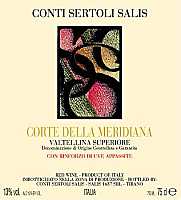
|
|
Valtellina Superiore Corte della Meridiana 2003 |
|
| Conti Sertoli Salis (Lombardy, Italy) | |
| Grapes: Nebbiolo (Chiavennasca) | |
| Price: € 19.00 | Score: |
| This wine shows a brilliant ruby red color and nuances of brick red, moderate transparency. The nose denotes intense, clean, pleasing and refined aromas which start with hints of cherry, plum and violet followed by aromas of blueberry, rose, raspberry, vanilla, tobacco, licorice, cinnamon, cocoa and menthol. The mouth has good correspondence to the nose, a tannic attack and pleasing crispness, however balanced by alcohol, full body, intense flavors. The finish is persistent with flavors of cherry, plum and blueberry. Valtellina Superiore Corte della Meridiana is produced with the “rinforzo” method and ages for 18 months in cask followed by at least 6 months of aging in bottle. | |
| Food Match: Game, Roasted meat, Braised and stewed meat, Hard cheese | |
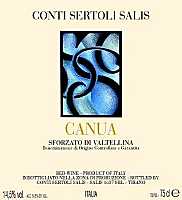
|
|
Sforzato di Valtellina Canua 2002 |
|
| Conti Sertoli Salis (Lombardy, Italy) | |
| Grapes: Nebbiolo (Chiavennasca) | |
| Price: € 32.00 | Score: |
| Sforzato di Valtellina Canua shows a brilliant ruby red color and nuances of brick red, moderate transparency. The nose reveals intense, clean, pleasing, refined and elegant aromas that start with hints of cherry, dried violet and prune followed by aromas of vanilla, dried rose, tobacco, leather, star anise, cinnamon, cocoa, pink pepper, licorice, mace and menthol. The mouth has good correspondence to the nose, a tannic attack and pleasing crispness, however balanced by alcohol, full body, intense flavors, agreeable roundness. The finish is very persistent with long flavors of cherry and prune. A well made wine. Sforzato di Valtellina Canua ages for 2 years in barrique followed by at least 6 months of aging in bottle. | |
| Food Match: Game, Braised and stewed meat, Roasted meat, Hard cheese | |
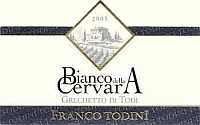
|
|
Colli Martani Grechetto di Todi Bianco della Cervara 2005 |
|
| Franco Todini (Umbria, Italy) | |
| Grapes: Grechetto | |
| Price: € 6.00 | Score: |
| The wine shows a pale straw yellow color and nuances of greenish yellow, very transparent. The nose denotes intense, clean, pleasing and refined aromas which start with hints of peach, pear and hawthorn followed by aromas of pineapple, chamomile, hazelnut, apple, broom and plum. The mouth has good correspondence to the nose, a crisp attack and however balanced by alcohol, good body, intense flavors, agreeable. The finish is persistent with flavors of peach, pear and pineapple. This wine ages in steel tanks. | |
| Food Match: Fried fish, Pasta and risotto with fish, Broiled fish and crustaceans | |
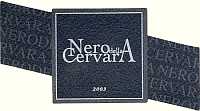
|
|
Nero della Cervara 2003 |
|
| Franco Todini (Umbria, Italy) | |
| Grapes: Merlot (50%), Cabernet Sauvignon (50%) | |
| Price: € 30.00 | Score: |
| Nero della Cervara shows an intense ruby red color and nuances of ruby red, little transparency. The nose denotes intense, clean, pleasing, refined and elegant aromas which start with hints of plum, black cherry and black currant followed by aromas of blueberry, vanilla, tobacco, licorice, chocolate, black pepper, mace and eucalyptus. The mouth has good correspondence to the nose, a tannic attack and pleasing roundness, however balanced by alcohol, good body, intense flavors, agreeable. The finish is persistent with flavors of black cherry, plum and black currant. Nero della Cervara ages for 12 months in barrique. | |
| Food Match: Roasted meat, Stewed and braised meat, Hard cheese | |
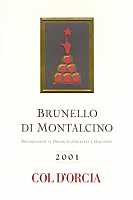
|
|
Brunello di Montalcino 2001 |
|
| Col d'Orcia (Tuscany, Italy) | |
| Grapes: Sangiovese | |
| Price: € 26.50 | Score: |
| This Brunello di Montalcino shows a brilliant ruby red color and nuances of garnet red, moderate transparency. The nose reveals intense, clean, pleasing, refined and elegant aromas that start with hints of plum, black cherry and blueberry followed by aromas of violet, vanilla, tobacco, leather, pink pepper, licorice, chocolate and menthol. The mouth has good correspondence to the nose, a tannic attack and pleasing crispness, however balanced by alcohol, full body, intense flavors, agreeable. The finish is persistent with flavors of plum and black cherry. A well made wine. This Brunello di Montalcino ages for 4 years in cask followed by 12 months of aging in bottle. | |
| Food Match: Game, Roasted meat, Braised and stewed meat, Hard cheese | |
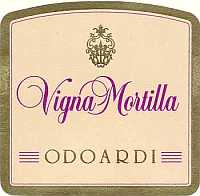
|
|
Savuto Superiore Vigna Mortilla 2001 |
|
| Odoardi (Calabria, Italy) | |
| Grapes: Gaglioppo (45%), Greco Nero (15%), Magliocco Canino (15%), Nerello Cappuccio, Sangiovese (25%) | |
| Price: € 18.00 | Score: |
| The wine shows an intense ruby red color and nuances of ruby red, little transparency. The nose denotes intense, clean, pleasing, refined and elegant aromas that start with hints of blackberry, plum and black cherry followed by aromas of blueberry, vanilla, violet, tobacco, licorice, chocolate, mace, pink pepper and menthol. The mouth has good correspondence to the nose, a tannic attack and however balanced by alcohol, full body, intense flavors, agreeable. The finish is persistent with flavors of blackberry, black cherry and plum. A well made wine. Savuto Superiore Vigna Mortilla ages for 14 months in barrique. | |
| Food Match: Game, Roasted meat, Stewed and braised meat, Hard cheese | |
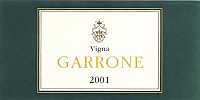
|
|
Scavigna Vigna Garrone 2001 |
|
| Odoardi (Calabria, Italy) | |
| Grapes: Gaglioppo (80%), Nerello Cappuccio (10%), Cabernet Franc (5%), Cabernet Sauvignon, Merlot (5%) | |
| Price: € 28.00 | Score: |
| Scavigna Vigna Garrone shows a deep ruby red color and nuances of ruby red, impenetrable to light. The nose reveals intense, clean, pleasing, refined and elegant aromas which start with hints of black cherry, blueberry and blackberry followed by aromas of plum, violet, vanilla, tobacco, black pepper, cocoa, licorice, clover, mace and menthol. The mouth has excellent correspondence to the nose, a tannic attack and however balanced by alcohol, full body, intense flavors, agreeable. The finish is very persistent with long flavors of black cherry, blueberry and blackberry. A well made wine. Scavigna Vigna Garrone ages for 18 months in barrique followed by 8 months of aging in bottle. | |
| Food Match: Game, Roasted meat, Braised and stewed meat, Hard cheese | |
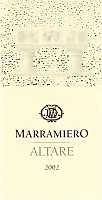
|
|
Trebbiano d'Abruzzo Altare 2002 |
|
| Marramiero (Abruzzo, Italy) | |
| Grapes: Trebbiano d'Abruzzo | |
| Price: € 11.50 | Score: |
| The wine shows an intense golden yellow color and nuances of golden yellow, very transparent. The nose reveals intense, clean, pleasing and refined aromas which start with hints of quince, plum and almond followed by aromas of citrus fruits, honey, hawthorn, vanilla and pear. The mouth has good correspondence to the nose, a crisp attack and pleasing roundness, however balanced by alcohol, good body, intense flavors. The finish is persistent with flavors of plum, quince and almond. Trebbiano d'Abruzzo Altare ages for 16-18 months in cask followed by 12 months of aging in bottle. | |
| Food Match: Stuffed pasta with mushrooms, Roasted white meat, Roasted fish | |

|
|
Montepulciano d'Abruzzo Inferi 2001 |
|
| Marramiero (Abruzzo, Italy) | |
| Grapes: Trebbiano d'Abruzzo | |
| Price: € 17.50 | Score: |
| The wine shows a deep ruby red color and nuances of garnet red, little transparency. The nose reveals intense, clean, pleasing, refined and elegant aromas which start with hints of blackberry, plum and black cherry followed by aromas of blueberry, vanilla, licorice, cocoa, cinnamon, tobacco, mace and black pepper. The mouth has good correspondence to the nose, a tannic attack and however balanced by alcohol, full body, intense flavors, agreeable. The finish is persistent with flavors of plum, blackberry and black cherry. A well made wine. Montepulciano d'Abruzzo Inferi ages for 24 months in steel tanks, 18 months in barrique and for 6 months in bottle. | |
| Food Match: Game, Roasted meat, Braised and stewed meat with mushrooms, Hard cheese | |
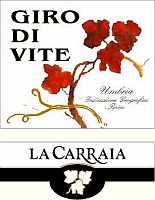
|
|
Giro di Vite 2004 |
|
| La Carraia (Umbria, Italy) | |
| Grapes: Montepulciano | |
| Price: € 14.00 | Score: |
| Giro di Vite shows a deep ruby red color and nuances of ruby red, little transparency. The nose denotes intense, clean, pleasing, refined and elegant aromas which start with hints of black cherry, plum and blueberry followed by aromas of violet, vanilla, tobacco, pomegranate, cinnamon, cocoa, carob, licorice and eucalyptus. The mouth has good correspondence to the nose, a tannic attack and however balanced by alcohol, good body, intense flavors. The finish is persistent with flavors of plum, black cherry and blueberry. A well made wine. Giro di Vite ages for 12 months in barrique followed by 6 months of aging in bottle. | |
| Food Match: Roasted meat, Braised and stewed meat, Hard cheese | |
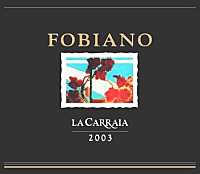
|
|
Fobiano 2004 |
|
| La Carraia (Umbria, Italy) | |
| Grapes: Merlot (70%), Cabernet Sauvignon (30%) | |
| Price: € 17.00 | Score: |
| The wine shows a deep ruby red color and nuances of purple red, little transparency. The nose denotes intense, clean, pleasing, refined and elegant aromas which start with hints of black cherry, black currant and plum followed by aromas of blueberry, vanilla, violet, tobacco, cocoa, pink pepper, mace and eucalyptus. The mouth has good correspondence to the nose, a tannic attack and however balanced by alcohol, good body, intense flavors, agreeable. The finish is persistent with flavors of black currant, plum and black cherry. A well made wine. Fobiano ages for 12 months in barrique followed by 6 months of aging in bottle. | |
| Food Match: Roasted meat, Braised and stewed meat, Hard cheese | |
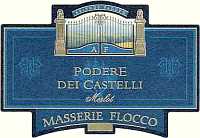
|
|
Podere dei Castelli Merlot 2005 |
|
| Masserie Flocco (Molise, Italy) | |
| Grapes: Merlot (95%) | |
| Price: € 7.00 | Score: |
| The wine shows a brilliant ruby red color and nuances of ruby red, moderate transparency. The nose has good personality with intense, clean, pleasing and refined aromas that start with hints of black cherry, raspberry and strawberry followed by aromas of blueberry, cyclamen, violet and plum. The mouth has good correspondence to the nose, a slightly tannic attack and however balanced by alcohol, good body, intense flavors, agreeable. The finish is persistent with flavors of black cherry, raspberry and strawberry. This wine ages in steel tanks. | |
| Food Match: Sauteed meat with mushrooms, Stuffed pasta, Broiled meat and barbecue | |

|
|
Molise Tintilia I Kuq 2004 |
|
| Masserie Flocco (Molise, Italy) | |
| Grapes: Tintilia | |
| Price: € 10.50 | Score: |
| This wine shows an intense ruby red color and nuances of garnet red, little transparency. The nose reveals good personality with intense, clean, pleasing and refined aromas which start with hints of cherry, plum and black currant followed by aromas of cyclamen, violet, pickle and black pepper. The mouth has good correspondence to the nose, a tannic attack and appreciable crispness, however balanced by alcohol, good body, intense flavors. The finish is persistent with flavors of cherry and plum. Molise Tintilia I Kuq ages in steel tanks. | |
| Food Match: Stuffed pasta, Sauteed meat with mushrooms, Broiled meat and barbecue | |
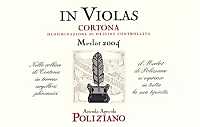
|
|
Cortona Merlot In Violas 2004 |
|
| Poliziano (Tuscany, Italy) | |
| Grapes: Merlot (85%), Cabernet Sauvignon (15%) | |
| Price: € 17.00 | Score: |
| This wine shows an intense ruby red color and nuances of ruby red, little transparency. The nose reveals intense, clean, pleasing, refined and elegant aromas that start with hints of black currant, plum and black cherry followed by aromas of blueberry, pink pepper, vanilla, tobacco, licorice, chocolate, graphite, mace and eucalyptus. The mouth has good correspondence to the nose, a tannic attack and pleasing roundness, however balanced by alcohol, good body, intense flavors. The finish is persistent with flavors of black currant, black cherry and plum. A well made wine. Cortona Merlot In Violas ages for 18 months in barrique followed by 6 months of aging in bottle. | |
| Food Match: Roasted meat, Braised and stewed meat, Hard cheese | |
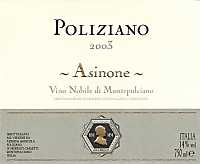
|
|
Vino Nobile di Montepulciano Asinone 2003 |
|
| Poliziano (Tuscany, Italy) | |
| Grapes: Prugnolo Gentile | |
| Price: € 31.00 | Score: |
| This Nobile di Montepulciano shows an intense ruby red color and nuances of ruby red, little transparency. The nose reveals intense, clean, pleasing, refined and elegant aromas that start with hints of plum, black cherry and blueberry followed by aromas of violet, black currant, tobacco, vanilla, pink pepper, graphite, cocoa, menthol and hints of rubber. The mouth has excellent correspondence to the nose, a tannic attack and however balanced by alcohol, full body, intense flavors, agreeable. The finish is very persistent with long flavors of black cherry, blueberry and plum. A well made wine. Vino Nobile di Montepulciano Asinone ages for 18 months in cask and in barrique followed by at least 8 months of aging in bottle. | |
| Food Match: Game, Roasted meat, Braised and stewed meat, Hard cheese | |
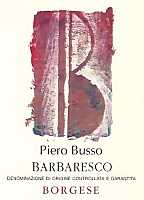
|
|
Barbaresco Vigna Borgese 2003 |
|
| Piero Busso (Piedmont, Italy) | |
| Grapes: Nebbiolo | |
| Price: € 23.50 | Score: |
| The wine shows a brilliant ruby red color and nuances of brick red, moderate transparency. The nose reveals intense, clean, pleasing, refined and elegant aromas which start with hints of cherry, plum and raspberry followed by aromas of violet, vanilla, tobacco, licorice, cinnamon, cocoa, mace and menthol. The mouth has good correspondence to the nose, a tannic attack and pleasing crispness, however balanced by alcohol, full body, intense flavors. The finish is persistent with flavors of cherry, plum and raspberry. Barbaresco Vigna Borgese ages for 24 months in cask followed by 6 months of aging in bottle. | |
| Food Match: Roasted meat, Game, Braised and stewed meat, Hard cheese | |

|
|
Barbera d'Alba S. Stefanetto 2004 |
|
| Piero Busso (Piedmont, Italy) | |
| Grapes: Barbera | |
| Price: € 15.00 | Score: |
| The wine shows a deep ruby red color and nuances of ruby red, little transparency. The nose reveals intense, clean, pleasing, refined and elegant aromas which start with hints of cherry, plum and black currant followed by aromas of blueberry, blackberry, violet, vanilla, tobacco, coffee, licorice, chocolate and menthol. The mouth has good correspondence to the nose, a tannic attack and pleasing roundness, however balanced by alcohol, good body, intense flavors. The finish is persistent with flavors of cherry, plum and black currant. Barbera d'Alba S. Stefanetto ages for 12 months in barrique followed by 12 months of aging in bottle. | |
| Food Match: Braised and stewed meat with mushrooms, Roasted meat, Hard cheese | |
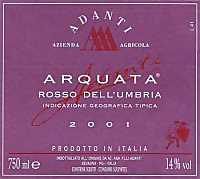
|
|
Arquata Rosso 2001 |
|
| Adanti (Umbria, Italy) | |
| Grapes: Cabernet Sauvignon, Cabernet Franc (40%), Merlot (40%), Barbera (20%) | |
| Price: € 16.00 | Score: |
| Arquata Rosso shows an intense ruby red color and nuances of ruby red, little transparency. The nose denotes intense, clean, pleasing, refined and elegant aromas which start with hints of black cherry, plum and black currant followed by aromas of blueberry, blackberry, licorice, tobacco, vanilla, violet, cocoa, cinnamon and eucalyptus. The mouth has good correspondence to the nose, a tannic attack and however balanced by alcohol, full body, intense flavors, agreeable. The finish is persistent with flavors of plum, black currant and black cherry. A well made wine. Arquata Rosso ages in cask for 24 months followed by 6 months of aging in bottle. | |
| Food Match: Game, Braised and stewed meat, Roasted meat, Hard cheese | |
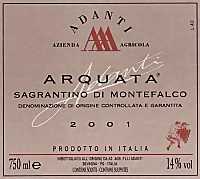
|
|
Sagrantino di Montefalco 2001 |
|
| Adanti (Umbria, Italy) | |
| Grapes: Sagrantino | |
| Price: € 21,00 | Score: |
| This Sagrantino di Montefalco shows an intense ruby red color and nuances of garnet red, little transparency. The nose reveals intense, clean, pleasing, refined and elegant aromas which start with hints of black cherry, blackberry and plum followed by aromas of blueberry, violet, vanilla, licorice, cocoa, cinnamon, leather, juniper, pink pepper, tobacco and menthol. The mouth has very good correspondence to the nose, a tannic attack and however balanced by alcohol, full body, intense flavors, agreeable. The finish is very persistent with long flavors of blackberry, black cherry and plum. A well made wine. This Sagrantino di Montefalco ages for 26 months in cask followed by 12 months of aging in bottle. | |
| Food Match: Game, Braised and stewed meat, Roasted meat, Hard cheese | |
|
||||||||
|
DiWineTaste Polls
|
| |||||||
Privacy Policy | |||||||


| Copyright © 2002-2024 Antonello Biancalana, DiWineTaste - All rights reserved |
| All rights reserved under international copyright conventions. No part of this publication and of this WEB site may be
reproduced or utilized in any form or by any means, electronic or mechanical, without permission in writing from DiWineTaste. |